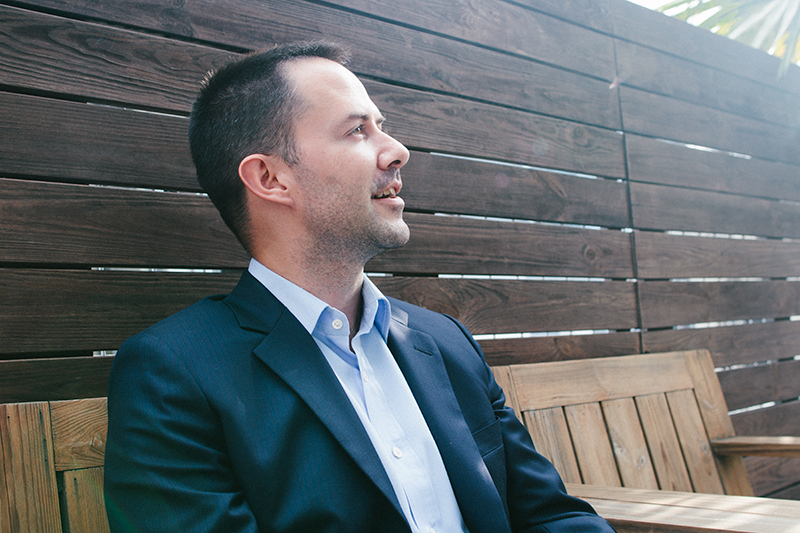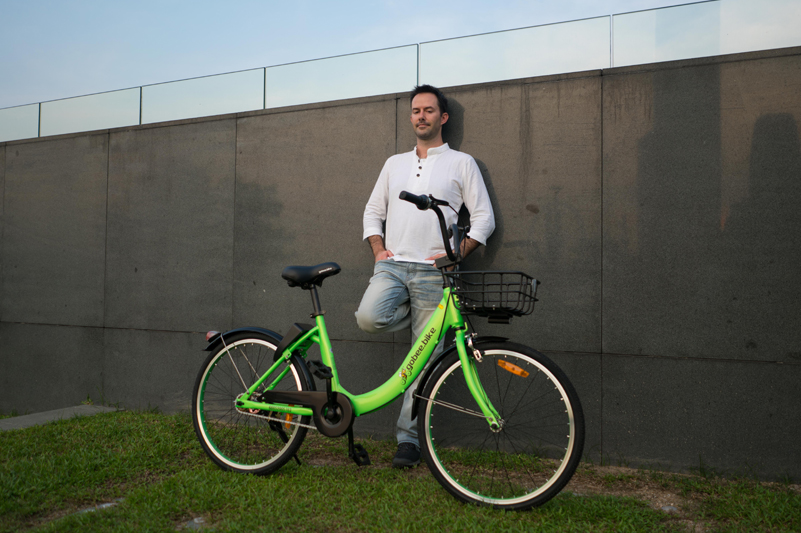Parked and ready to use, GoBee Bikes are stationed around the streets of Hong Kong to make your commuting life easier. Co-Founder Claude Ducharme discusses how it all started and what problems he still faces.

Out of a total of 185 countries, Entrepreneur and Co-Founder of Gobee.bike Claude Ducharme has traveled to an impressive 58, but his ambitions didn’t stop there. After moving from Montreal to Paris, Ducharme remained in Paris for some time until his desire for adventure had taken him by the ankles and led him further east.
Now residing in the bustling city of Hong Kong, Ducharme has established a bicycle sharing service which allows users to complete part, if not all, of their commuting journey while promoting a healthier transport alternative. The idea for GoBee Bikes began in February 2017 and launched in less than 2 months with only 1000 bicycles. Despite countless criticisms, Ducharme keeps his mind positive and remains ambitious with his business. From February to August, the team has grown rapidly with 75 people currently on the payroll.
Dressed in a light blue shirt and a smart navy blazer, we met Ducharme on a late Wednesday afternoon to discuss how Go.Bee Bike started, what problems he faced and still faces, and how he deals with negativity.
Would you be able to describe a typical working day is like for you?
There is no typical day for me. I am in charge of the IT so I just have to make sure that the IT can expand by looking at different countries, competitors and managing people in general. We are currently finding a new office as we are running out of space. We also are setting an ERP – an Enterprise Resource Planning system which will take few months to configure.
Have you always wanted to be an entrepreneur?
It was a curiosity all along. As much as the traveling, exploring my ideas and projects at home. Around two years ago, I did the Founder Institute program, and that gave me an insight about business and how to study the topics.
With work experiences in investment banking and IT and now a consumer-based business, how was the transition?
It’s a radical shift but you see it often in Hong Kong where people leave finance. I was doing corporate investment banking before. Banks are usually big monolithic blocks and often bureaucracy slows down the execution pace. Now they try to catch up fintech company speed but it requires huge efforts and restructuration.
I think it’s a good thing to have a background in banking. As you can see from your experience of what works and what doesn’t work. I worked for the same bank in Paris and in Hong Kong, but the environment was different–it was the same company but the way people interact is very different.
Was there a particular moment that stood out when you decided to make the jump from banking to launching a startup?
I had many ideas but you need to have some traction; you need to know where to start. With GoBee Bike, my Co-Founder Raphael knew what to do so when he came to me with the idea I quickly jumped on the opportunity.
Launching a startup is a risk, how was the response when you launched Go.Bee?
Some investors were not happy with the premature launch. The iOS version was not ready at the beginning, and they said we should postpone. I was still waiting for the D-U-N-S code to be able to publish on the Appstore. The flow in the app was not perfect, and we spent many hours to fix the first version.
Do you remember the moment when you realised bike sharing could be a business model?
I’ve been cycling since I was 4 years old in Canada. If I wanted to see my friends, I had to cycle as this is usually what we had to do. I remember in university I would cycle to the supermarket to buy groceries. France was a little less bicycle friendly however in Hong Kong we have so much greenery. This was the perfect location to set up a bike sharing service.
I was renting bicycles myself back then, cycling to Shatin, to Tai Po, and then coming back at sunset mostly on Saturdays. It is expanding in China and we want to share the same convenience here in Hong Kong.
What is the toughest part of your job?
Time management. You are approached by so many people so you need to multitask a lot and handle the occasional crisis. I’ve seen it in banks before and usually the problem revolved around millions of dollars so it was a little less stressful this time round. Putting resources where it is mostly needed is also another main problem, but you need to prioritize by making a decision.
Why did you decide to launch in Hong Kong?
We both live in Hong Kong so, after research, it made sense to start here so after Raphael had the initial idea, a few weeks later I quit my job to be full time. We went on a trip to Shenzhen, and we bought the first batch of bicycles. One thing about entrepreneurs is that if you want to succeed, it is all about the execution. We put a few thousand US dollars to buy the first IT system along with the first batch of bicycles, and then three days after I decided to quit my job as we had made up our minds to do it.
Hong Kong is the place to be to get things done quickly. We can go to the factories in the morning and come back in the evening. Hong Kong has the infrastructure as well. There are also more than fifty thousand parking spots meaning it is quite safe, plus the beauty of the scenery.
How did you meet your business partner?
We met at a beer festival 5 years ago and then I saw him again at the Founder Institute. We were mostly hanging out, talking about work but we had never worked together before.
One day he came to me, he sent me a message asking if I was free for lunch and so I agreed. At that time, I was working for a broker and he mentioned the CTO and Co-Founder position for the company he had in mind.
How did you know when to launch?
We asked the factory when the bikes and the prototype IT system would be ready, and so they said a few weeks. We decided to put a small buffer just after. It was rushed; we were two people who decided the idea in late February and we launched in mid-April.
With such a rushed launch, how many bikes were there in the first batch?
We had 1000 but the factory had some issues so we only received 400 for the launch date. However, a while after we received the remaining 600. It needs to be convenient if people pay for the app and they don’t see the bikes, they would need to walk instead. We don’t want them to chase the bicycles; we want it to be right there.
GoBee.Bike is impacting the city and improving the lives of people; would you call yourself a business venture or a social enterprise?
We want people to be healthy by cycling. We are collecting data on where people are going and at what time in the day they are traveling. We can work with civil engineers to possibly make the cycling routes better and to provide suggestions on where to put the next parking spots.
How did you decide on the design of GoBee.Bike?
We decided everything on the first day we went to the factory and we decided the colour together within a few minutes. We were using the internet and going on government websites to look at the regulations.
There hasn’t been a lot of change in the original design but there were some issues like the lights were easily removable, so we had the factory change them. As for the bicycle handles, the first version was easy to remove so now it stays in place.
We’ve heard that your team has grown from 2 to 75 in less than a year- can you share some of your secrets?
We spent a tremendous amount of time recruiting the right people. Raphael has an extensive network as he has worked with companies such as Food Panda and Rocket Internet. He has many years of experience in startups so he recognises good candidates easily and understands how to reach people.
He is also a good sales guy so that helps a lot. For IT, I’ve worked with many people so I know how to recruit the right types of people. Recruiting is quite important because it is impossible to do everything ourselves. Building a team with a similar culture is the key to success.
How did you secure your funding in such a short amount of time?
The seed round lasted around 2 weeks, and it became over-subscribed to the point where people were asking to put more money in it but we said no.
What types of people are you targeting your business at?
People who are looking to travel to MTR stations from their house, or coming back from work. It’s a great alternative to the long queues for the minibus. At the moment people are using it for leisure on the weekends, and we hope they will use it on a day-to-day basis as the weather is cooler in autumn and spring.
How do you decide where to station your bikes?
We use public parking spaces, and we also put them near cycling paths as it is convenient. Hong Kong has a dense population, so we try to station them in districts.
There have been reports of abuse and vandalism of shared bikes popping up on social media, how do you make sure that bikes are maintained to standards?
We are hiring more people so that we have operation assistants, managers, and people to help with customer service. We sometimes receive complaints, so we handle these first. There are also routine checks made by residents in the area. We aim to hire people locally so that they can do checks and bring the broken bikes into the warehouses.
Speaking of complaints, how do you deal with criticism and when do you know which feedback to take on board?
We take criticism positively as we try to improve the bicycles, the IT system and the app. Right now we are working on on the UI/UX (user experience) of the app as we have received comments on it.
When the feedback is long and written angrily, we review it objectively to extract the pain points from user frustrations. We are thankful to those who take time to write feedback. On the other hand, when users send personal emails with specific points to improve along with screenshots, I treasure these messages as I feel them very committed.
Most cyclists cycle in the New Territories for leisure. Do you have any strategy to encourage people to cycle on the Island side?
The infrastructure in Hong Kong Island is not ready, and we prefer users to cycle in safe places. Queens Road East is a little hard so we put some bicycles in Cyberport and Aberdeen. Hopefully in the future we can have bicycles on the harbour front from Kennedy Town to Chai Wan, and across the harbour too.
How do you see the future of Gobee?
The funding that we received for series A was to improve the service in Hong Kong and start the model in Europe by the end of the year.
Edited by Hayden Lee
Details
Address: WeWork, 33 Lockhardt Road, Wan Chai, Hong Kong
Telephone: (+852) 3018 1708
gobee.bike
Related Articles





